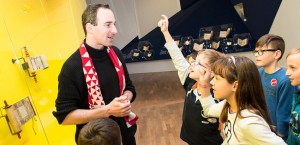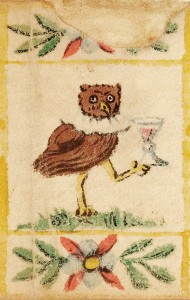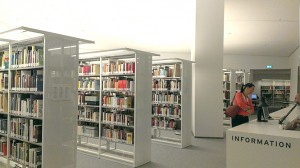
Schoolchildren on a guided tour of the exhibition “The Creation of the World”
© Jewish Museum Berlin, photo: Nadja Rentzsch
“I know!” shouts Tamo* (aged 10): “It’s Jewish writing!” “It’s called Hebrew—Hebrew writing” Mia (aged 10) corrects him. She knows the term because her best friend comes from Israel. She has seen letters like this before, at her friend’s house. Alexander (aged 34) chuckles. He works at the Jewish Museum and is giving a group of primary schoolchildren from Berlin a tour of “The Creation of the World,” our current temporary exhibition. On display are historical manuscripts and artful illustrations. → continue reading
Preparing for the Educational Program on the Exhibition “The Creation of the World”

Detail from a Megilla (Esther scroll), 1750-1800, Alsace
© Braginsky Collection, Zurich, photo: Ardon Bar-Hama
As a part of the educational program accompanying the exhibition “The Creation of the World: Illustrated Manuscripts from the Braginsky Collection” we’re offering the workshop “But the Snake was Craftier…” about telling and passing down stories from generation to generation. Since very few of the schoolchildren who will participate in the workshop can read Hebrew, we’ll be looking closely at the illustrations. In addition to portrayals of David with the harp and Adam and Eve in the manuscripts, our program looks at the megillot, or Esther scrolls, with their illustrations. Six scrolls have been unrolled to their full length for the exhibition.
Before we take participants in to see the exhibition, a guide will tell the story of Esther. During this conscious act of listening, each person generates pictures in his or her own mind’s eye. Afterwards, the group visits the exhibition and looks at the Esther scrolls with a magnifying glass to re-discover the scenes they’ve heard about.
To prepare for this workshop, we consulted a storytelling expert. Ten museum employees met with Prof. Dr. Kristin Wardetzky to practice storytelling under her tutelage. The first chairwoman of the Society for the Art of Storytelling, Prof. Wardetzky also founded the storytelling department at the Berlin University of the Arts’ theater education department.
Our two-day workshop with Prof. Wardetzky enthralled us all. → continue reading
A Visit to the Academy’s Reading Room
Why do we keep books like Muslime im säkularen Rechtsstaat (Muslims in Secular Rule of Law), Diaspora Identities, or z.B. 650 Jahre Rixdorf (E.g. 650 Years of Rixdorf) at the Jewish Museum? Answering this question is the task of the Academy Programs on Migration and Diversity. How to find these books, however, falls to the library.

Reading room of the Jewish Museum Berlin’s library
© Jewish Museum Berlin, photo: Mirjam Bitter
Imagine that you want to learn about social structures, clubs, and immigrant biographies in Berlin, particularly in Kreuzberg, to which you yourself moved from Hesse two years ago. After visiting the museum one fine Sunday afternoon, you take a look at the new Academy, where, you heard, a friend of yours recently attended an event about the ‘new Germans.’ The Academy is closed on the weekend, but a museum host informs you that it has a library. You return on Monday and ask in the reading room about Turks in Kreuzberg. The librarian would love just to tell you, “second shelf on the left, all the way to the back – what you’re looking for is right there.” Unfortunately, it’s not quite that simple. → continue reading


